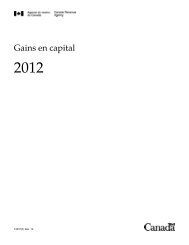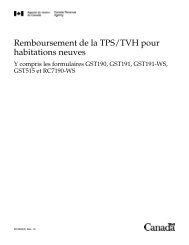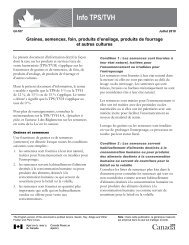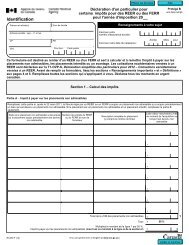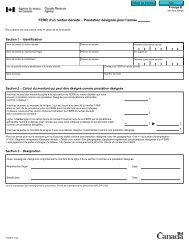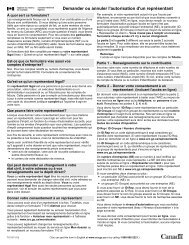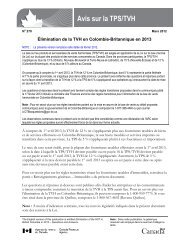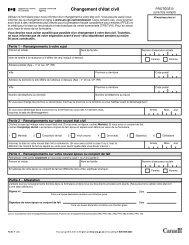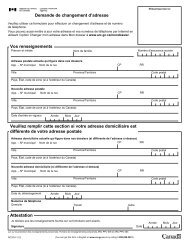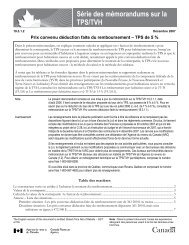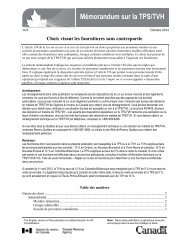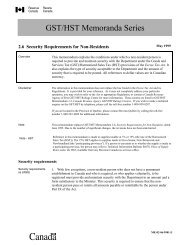CRA Annual Report to Parliament 2011-2012 (PDF - Agence du ...
CRA Annual Report to Parliament 2011-2012 (PDF - Agence du ...
CRA Annual Report to Parliament 2011-2012 (PDF - Agence du ...
You also want an ePaper? Increase the reach of your titles
YUMPU automatically turns print PDFs into web optimized ePapers that Google loves.
2. Summary of significant accounting policies<br />
For financial reporting purposes, the <strong>CRA</strong>’s activities have been divided in<strong>to</strong> two sets of financial statements: agency activities<br />
and administered activities. The Financial Statements - Agency Activities include those operational revenues and expenses<br />
which are managed by the <strong>CRA</strong> and utilized in running the organization. The Financial Statements - Administered Activities<br />
include those revenues and expenses that are administered on behalf of the federal, provincial, and terri<strong>to</strong>rial governments,<br />
First Nations, and other organizations. The purpose of the distinction between agency and administered activities is <strong>to</strong><br />
facilitate, among other things, the assessment of the administrative efficiency of the <strong>CRA</strong> in achieving its mandate. Taxrelated<br />
assets, liabilities, revenues and expenses are excluded from these financial statements because they can only accrue<br />
<strong>to</strong> a government, not <strong>to</strong> the tax agency that administers those transactions.<br />
As required by the Canada Revenue Agency Act, the Financial Statements - Agency Activities have been prepared using<br />
accounting principles consistent with those applied in the preparation of the financial statements of the Government of<br />
Canada. The accounting principles used are based on Canadian public sec<strong>to</strong>r accounting standards. A summary of significant<br />
accounting policies follows:<br />
(a) <strong>Parliament</strong>ary appropriations<br />
The <strong>CRA</strong> is financed by the Government of Canada through <strong>Parliament</strong>ary appropriations. Accounting for appropriations<br />
provided <strong>to</strong> the <strong>CRA</strong> does not parallel financial reporting according <strong>to</strong> Canadian public sec<strong>to</strong>r accounting standards, as<br />
they are based in large part on cash flow requirements. Consequently, items recognized in the Statement of Financial<br />
Position and the Statement of Operations and Agency Net Financial Position may be different from those provided<br />
through appropriations from <strong>Parliament</strong>. Note 3(b) provides a high-level reconciliation between the two bases of<br />
reporting. The planned results in the Statement of Operations and Agency Net Financial Position are the amounts<br />
reported in the Future-oriented Financial Statements - Agency Activities included in the <strong>2011</strong>-<strong>2012</strong> <strong>Report</strong> on Plans and<br />
Priorities.<br />
(b) Net cash provided by the Government of Canada<br />
The <strong>CRA</strong> operates within the Consolidated Revenue Fund (CRF), which is administered by the Receiver General for<br />
Canada. All cash received by the <strong>CRA</strong> is deposited <strong>to</strong> the CRF and all cash disbursements made by the <strong>CRA</strong> are paid from<br />
the CRF. The net cash provided by government is the difference between all respendable cash receipts and all cash<br />
disbursements including transactions with departments and agencies.<br />
(c) Expense recognition<br />
Expenses are recognized when goods are received and/or services are rendered.<br />
(d) Services provided without charge from other government agencies and departments<br />
Estimates of the cost for services provided without charge from other government agencies and departments are<br />
included in expenses.<br />
(e) Revenue recognition<br />
Non-tax revenue is recognized when the services are rendered by the <strong>CRA</strong>.<br />
Non tax revenues that are not available for spending cannot be used <strong>to</strong> discharge the <strong>CRA</strong>’s liabilities. While<br />
management is expected <strong>to</strong> maintain accounting control, it has no authority regarding the disposition of nonrespendable<br />
revenues. As a result, non-respendable revenues are considered <strong>to</strong> be earned on behalf of the Government<br />
of Canada and are therefore presented in re<strong>du</strong>ction of the <strong>CRA</strong>’s gross revenues.<br />
(f) Vacation pay and compensa<strong>to</strong>ry leave<br />
Vacation pay and compensa<strong>to</strong>ry leave are expensed as the benefits accrue <strong>to</strong> employees under their respective terms of<br />
employment. The liability for vacation pay and compensa<strong>to</strong>ry leave is calculated at the salary levels in effect at the end of<br />
the year for all unused vacation pay and compensa<strong>to</strong>ry leave benefits accruing <strong>to</strong> employees.<br />
CANADA REVENUE AGENCY<br />
87<br />
ANNUAL REPORT<br />
<strong>2011</strong>-<strong>2012</strong>



